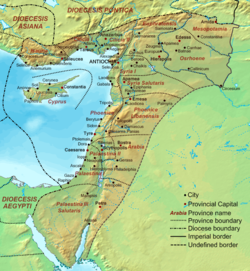- Diocese of the East
-
Dioecesis Orientis
Ἐῴα Διοίκησις
Diocese of the EastDiocese of the Roman Empire 314 – 630s The Diocese of the East ca. 400 AD. Capital Antioch Historical era Late Antiquity - Established 314 - Arab conquest 638 The Diocese of the East (Latin: Dioecesis Orientis, Greek: Ἐῴα Διοίκησις) was a diocese of the later Roman Empire, incorporating the provinces of the western Middle East, between the Mediterranean Sea and Mesopotamia. During late Antiquity, it was one of the major commercial, agricultural, religious and intellectual areas of the Empire, and its strategic location facing the Sassanid Empire and the unruly desert tribes gave it exceptional military importance.[1]
Its capital was at Antioch, and its governor had the special title of comes Orientis ("Count of the East", of the rank vir spectabilis and later vir gloriosus) instead of the ordinary "vicarius". The diocese was established after the reforms of Diocletian, and was subordinate to the Praetorian prefecture of the East.[1] It presumably lasted until its territories were finally overrun by the Muslim conquest in the 630s.
The diocese included originally all Middle Eastern provinces: Isauria, Cilicia, Cyprus (until 536), Euphratensis, Mesopotamia, Osroene, Syria, Phoenice, Palaestina, Arabia, as well as the provinces of Aegyptus, Augustamnica, Thebais, Libya Superior and Libya Inferior which were grouped into the separate Diocese of Egypt under Valens.[1] During the course of the 4th century, the several provinces were split, resulting in the new provinces of Cilicia I and Cilicia II, Syria I and Syria Salutaris, Phoenice Libanensis (east of the Mt. Lebanon), Palestina I, Palestina II and Palestina Salutaris (or Palestina III). The last creation of a new province dated in the reign of Justinian I, when Theodorias, the region around Laodicea, was split off from Syria I.
List of Comites Orientis
- Lollianus Mavortius (330-336)
- Felicianus (335-?)
- Nebridius (354–358)
- Domitius Modestus (358–362)
- Iulianus (362–363)
- Aradius Rufinus (363–364)
- Eutolmius Tatianus (ca. 370)
- Tuscianus (381)
- Flavius Eparchius Philagrius (ca. 382)
- Proculus (383–384)
- Icarius (ca. 384)
- Irenaeus (431–435)
- Ephraim of Amida (ca. 522-ca. 525)
- Asterius (587–588)
- Bacchus (588–589)
- Bonosus (ca. 609–610)
References
- ^ a b c Kazhdan, Alexander, ed (1991). Oxford Dictionary of Byzantium. Oxford University Press. pp. 1533–1534. ISBN 978-0-19-504652-6.
Categories:- States and territories established in 314
- Ancient Rome stubs
- Byzantine Empire stubs
- Civil dioceses of the Roman Empire
- History of Syria
- History of the Middle East
- Civil dioceses of the Byzantine Empire
Wikimedia Foundation. 2010.

